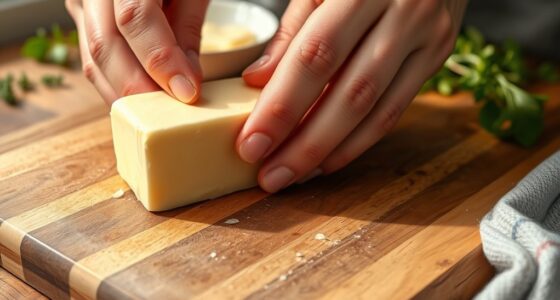I’ve always wondered how butter chicken actually tastes. It’s a well-known dish I’ve frequently heard praised, yet I’ve never had the opportunity to taste it firsthand. Therefore, I made the decision to delve into and experience the flavors and textures of this famous Indian cuisine myself.
In this article, I’ll be sharing my findings about the origins, ingredients, cooking techniques, and regional differences of butter chicken. Get ready to discover the mouthwatering experience that awaits when you take your first bite.
Key Takeaways
- Butter chicken has a well-balanced flavor profile with a combination of sweetness from tomatoes and cream, warmth and depth from spices, tanginess from tomatoes and yogurt, and creaminess from butter and cream.
- The dish has a rich and fragrant aroma that enhances the dining experience.
- Butter chicken has a velvety texture that adds to its appeal.
- The spiciness of butter chicken can vary from mild to moderately spicy, and there are variations in flavor and garnishes based on regional differences and popular adaptations in different countries.
The Origins of Butter Chicken
Butter chicken, also known as murgh makhani, is said to have originated in the early 20th century in Delhi, India. The evolution of butter chicken has been influenced by various culinary traditions and has become a beloved dish worldwide.
Its cultural significance lies in its ability to bring people together, bridging gaps between different communities and cultures. As a classic Indian dish, butter chicken showcases the rich flavors and aromatic spices that define Indian cuisine.
The succulent pieces of chicken are marinated in a flavorful mixture of yogurt and spices, then cooked in a creamy tomato-based gravy. The tender chicken, coated in a velvety sauce, creates a harmonious balance of flavors that is both comforting and indulgent.
With its origins rooted in Delhi’s vibrant food scene, butter chicken has become an iconic dish that represents the diverse and complex history of Indian cuisine.
Now, let’s delve into the ingredients used in butter chicken.
The Ingredients Used in Butter Chicken
If you’re curious about the flavors in butter chicken, you’ll be interested to know that the dish typically includes a combination of aromatic spices, such as garam masala and cumin. These spices give butter chicken its rich and complex taste.
The preparation process involves marinating chicken in a mixture of yogurt and spices, which helps to tenderize the meat and infuse it with flavor. The chicken is then cooked in a creamy tomato-based sauce, which is made with butter, onions, garlic, ginger, and a blend of spices.
The result is a dish that is creamy, savory, and slightly tangy. In terms of nutritional value, butter chicken is high in protein from the chicken and yogurt, but it is also rich in fat and calories due to the butter and cream.
The Cooking Techniques for Butter Chicken
When making butter chicken, you’ll want to start by marinating the chicken in a mixture of yogurt and spices. This not only helps to tenderize the meat but also infuses it with flavors.
After marinating, the chicken is typically cooked in a tandoor or grilled to give it a smoky and charred flavor.
The cooked chicken is then simmered in a rich and creamy tomato-based sauce, which is made by combining butter, onions, garlic, ginger, and a blend of aromatic spices.
The sauce is slow-cooked to develop complex flavors and to allow the chicken to absorb the richness of the sauce.
The cooking techniques used in butter chicken result in a dish that has a well-balanced flavor profile, with a combination of tanginess, creaminess, and a hint of smokiness.
The Spices and Flavors in Butter Chicken
The spices and flavors in butter chicken create a deliciously rich and aromatic dish that is full of depth and complexity. The cooking techniques used to prepare butter chicken enhance the flavors and create a dish that is truly special.
The key spices used in this dish include garam masala, turmeric, cumin, coriander, and chili powder. These spices are toasted to release their flavors and then combined with other ingredients like garlic, ginger, and tomatoes to create a flavorful base. The addition of butter and cream adds a creamy and luxurious element to the dish, balancing out the spices and creating a harmonious combination of flavors.
Butter chicken not only tantalizes the taste buds but also holds cultural significance as a popular dish in Indian cuisine. Its rich flavors and aromatic spices make it a standout dish that is enjoyed by many around the world.
The Creaminess and Texture of Butter Chicken
The creaminess and texture of butter chicken are achieved by combining butter and cream with the flavorful base of spices, creating a luscious and velvety sauce.
The richness of butter chicken lies in its creamy tomato sauce, which is made by simmering tomatoes, onions, and spices in a mixture of butter and cream. This combination creates a thick and smooth sauce that coats the tender pieces of chicken.
The creamy tomato sauce is not only visually appealing, but it also adds a depth of flavor and richness to the dish. The butter and cream add a luxurious and indulgent element to the sauce, creating a dish that is both comforting and satisfying.
The velvety texture of the sauce enhances the overall dining experience, making every bite of butter chicken a delight to savor.
The Level of Spiciness in Butter Chicken
To experience the level of spiciness in butter chicken, start by taking a small bite and let the flavors slowly unfold on your taste buds. The spiciness can vary depending on the recipe and personal preference. Some may find it mild with just a hint of spice, while others may find it moderately spicy.
Here are some key characteristics of the level of spiciness in butter chicken:
- Rich and creamy tomato-based sauce with a balance of flavors.
- Warm and aromatic spices like garam masala, cumin, and turmeric.
- The heat from chili powder or fresh green chilies.
- A touch of tanginess from yogurt or lemon juice.
In addition to its delicious taste, butter chicken also offers some health benefits. It is a good source of protein from the chicken, and the spices used, like turmeric and ginger, have anti-inflammatory properties. However, it’s important to be mindful of portion sizes and the amount of butter and cream used in the recipe.
The Balance of Sweet and Savory in Butter Chicken
For those who prefer a harmonious blend of sweet and savory flavors, butter chicken offers a perfect balance. Its combination of rich tomato-based sauce and warm aromatic spices creates a truly delectable experience for the taste buds. This traditional recipe hails from the Indian subcontinent, where it has been enjoyed for generations.
The balance of flavors in butter chicken is achieved through the careful use of ingredients. Tomatoes, cream, butter, and a blend of spices like garam masala, cumin, and coriander all play a role. The sweetness of the tomatoes and cream is expertly balanced by the warmth and depth of the spices.
The result is a dish that is both comforting and complex. Each bite offers a symphony of flavors that dance on the palate.
The Aroma of Butter Chicken
As I take a deep breath, the rich and fragrant aroma of butter chicken fills the room, instantly awakening my senses.
The combination of spices and herbs creates a tempting and mouthwatering scent that is simply irresistible.
The aroma alone is enough to make my mouth water, and I can’t wait to indulge in the flavorful experience that awaits me.
Rich and Fragrant Aroma
You’ll immediately notice the rich and fragrant aroma of butter chicken as it simmers on the stove. The combination of aromatic spices like cumin, coriander, and garam masala creates a tantalizing scent that fills the air.
The warm and inviting smell of the buttery tomato-based sauce is enough to make your mouth water. As the chicken cooks slowly, the flavors meld together, resulting in a dish with a beautifully balanced taste.
The rich flavor of the creamy sauce is complemented by the tanginess of the tomatoes and the slight heat from the spices. Each bite is a harmonious blend of creamy, savory, and slightly spicy flavors.
It’s no wonder that butter chicken is a popular dish loved by many.
Tempting and Mouthwatering Scent
The tantalizing scent of butter chicken simmering on the stove is enough to make anyone’s mouth water. The tempting aroma fills the air, wafting through the house and drawing everyone to the kitchen. It’s a symphony of spices, with notes of cumin, coriander, and garam masala dancing together, creating an irresistible fragrance that lingers in the air. The table below showcases the key ingredients that contribute to this mouthwatering scent:
| Ingredient | Aroma |
|---|---|
| Butter | Rich |
| Garlic | Savory |
| Ginger | Spicy |
| Tomatoes | Tangy |
| Fresh Cream | Creamy |
As the scent permeates the room, anticipation builds for the first bite. The butter chicken has a complexity of flavors that are balanced perfectly. The spices meld together, creating a harmony of taste that is both comforting and exciting. The creamy tomato-based sauce coats the tender pieces of chicken, infusing them with its rich flavor. It’s a dish that satisfies both the senses and the soul. Transitioning to the next section, the color and presentation of butter chicken is as enticing as its scent and taste.
The Color and Presentation of Butter Chicken
When it comes to food, presentation matters. The vibrant and appetizing colors of a dish can immediately stimulate the senses and make our mouths water in anticipation.
But it’s not just about looks – plating can actually enhance the flavors of a dish, as the arrangement of ingredients can create a harmonious balance of tastes and textures.
Furthermore, research suggests that the visual appeal of a dish can also influence our perception of its taste, making it even more enjoyable to eat.
Vibrant and Appetizing
Feast your senses on the vibrant and appetizing flavors of butter chicken. This classic Indian dish is a tantalizing blend of spices, herbs, and creamy tomato sauce. Here’s what makes it so irresistible:
- Tender, juicy chicken marinated in a rich yogurt and spice mixture, resulting in a melt-in-your-mouth texture.
- A medley of aromatic spices like cumin, coriander, garam masala, and turmeric, which create a symphony of flavors that dance on your taste buds.
- The velvety tomato-based sauce, infused with butter and cream, adds a luscious and decadent element to the dish.
- The balance of sweet, tangy, and savory flavors that play off each other, creating a harmonious and complex taste experience.
Each bite of butter chicken is a delightful explosion of flavors that will leave you craving for more. And when it comes to enhancing these enticing flavors, plating plays a crucial role.
Plating Enhances Flavors
To enhance the flavors of butter chicken, you can artfully arrange the dish on a plate, adding visual appeal and elevating the overall dining experience. Plating techniques play a vital role in how we perceive food. The way a dish is presented can influence our sensory perception and enhance our enjoyment of the meal.
When it comes to butter chicken, a popular Indian dish known for its rich and creamy flavors, a well-plated presentation can make all the difference.
One effective plating technique for butter chicken is to use a white plate as a canvas. This allows the vibrant colors of the dish to stand out, creating a visually appealing contrast. Arrange the chicken pieces in a neat and orderly manner, and drizzle the creamy sauce over them. Garnish with fresh cilantro and a sprinkle of red chili flakes for a touch of heat.
Visual Appeal Influences Taste
You can enhance your dining experience by considering how the visual appeal of a dish influences your perception of taste. Visual aesthetics play a significant role in our sensory stimulation and can greatly impact our enjoyment of food.
When a dish is visually appealing, it can create anticipation and excitement, enhancing the overall dining experience. Here are four ways in which visual appeal influences taste:
-
Color: Bright and vibrant colors can make a dish more visually appealing and appetizing.
-
Presentation: The way a dish is presented can affect our perception of taste. A well-arranged plate can make the food look more enticing.
-
Garnishes: Adding garnishes like herbs or edible flowers can add visual interest and enhance the overall presentation.
-
Texture: Different textures in a dish can create a visually appealing contrast, making it more enjoyable to eat.
Considering the visual aesthetics of a dish can enhance the sensory experience and make your dining experience more memorable.
The Popular Variations of Butter Chicken
If you’re a fan of Indian cuisine, you’ll be delighted to explore the popular variations of butter chicken.
Butter chicken, also known as murgh makhani, is a rich and creamy dish that originated in the Indian subcontinent. It is made by marinating chicken in a mixture of yogurt and spices, then cooking it in a tomato-based sauce with butter and cream.
The variations in butter chicken recipes are endless, with each region adding its own unique twist to the dish. In some recipes, additional spices like garam masala or fenugreek are added to enhance the flavor.
Butter chicken has gained immense popularity not only in India but also in countries like the United Kingdom, Canada, and the United States, where it is often served in Indian restaurants and enjoyed by people of different cultures.
The Best Accompaniments for Butter Chicken
When it comes to enjoying a delicious plate of butter chicken, choosing the perfect side dishes and complementary flavor pairings can elevate the dining experience to a whole new level.
The right side dishes can provide a balance of textures and flavors, enhancing the richness and depth of the butter chicken.
Additionally, pairing the dish with complementary flavors can create a harmonious combination that tantalizes the taste buds and leaves you craving for more.
Perfect Side Dishes
There’s nothing like some garlic naan to accompany butter chicken. The warm, buttery bread perfectly complements the rich and flavorful chicken dish.
But if you’re looking for more options to enhance your butter chicken experience, here are some perfect side dishes to consider:
-
Fragrant Basmati Rice: The fluffy grains of basmati rice provide a neutral base to balance out the bold flavors of the butter chicken.
-
Cucumber Raita: This refreshing yogurt-based side dish cools down the spiciness of the chicken, while adding a creamy and tangy element.
-
Aloo Gobi: This classic Indian dish of spiced potatoes and cauliflower brings a hearty and comforting texture to the meal.
-
Mixed Vegetable Pulao: A medley of vegetables cooked with aromatic spices and rice, this dish adds a burst of color and nutrients to your plate.
These perfect side dishes not only provide a variety of textures and flavors, but also create complementary flavor pairings that elevate your butter chicken experience.
Complementary Flavor Pairings
Enhance your butter chicken experience with these perfect side dishes that create complementary flavor pairings. When it comes to enjoying a flavorful meal, finding the right combination of dishes is key. The table below showcases some of the best options to accompany your butter chicken, creating a symphony of flavors on your palate.
| Side Dish | Flavor Pairing |
|---|---|
| Garlic Naan | Creamy and aromatic |
| Cucumber Raita | Refreshing and cooling |
| Basmati Rice | Light and fragrant |
| Aloo Gobi | Spicy and tangy |
| Mango Chutney | Sweet and tangy |
Garlic Naan, with its soft, buttery texture, complements the rich and creamy flavors of butter chicken. Cucumber Raita adds a refreshing element to balance out the heat of the dish. Basmati Rice, with its delicate aroma, provides a light and fragrant base for the flavorful chicken. Aloo Gobi, a spicy cauliflower and potato dish, adds a tangy kick that harmonizes with the bold flavors of the butter chicken. Lastly, Mango Chutney brings a burst of sweetness and tanginess that adds a delightful contrast to the savory chicken. These side dishes elevate the butter chicken experience, creating a perfect harmony of complementary flavors.
The Regional Differences in Butter Chicken
You’ll notice that depending on where you try it, butter chicken can vary in taste due to the regional differences. The regional variations in butter chicken can be attributed to the different cooking methods used across India.
Here are some interesting aspects to consider:
-
Spices: Different regions in India use their own unique blend of spices to make butter chicken. This can result in variations in the flavor profile, with some regions opting for a spicier taste while others may focus more on the richness of the sauce.
-
Ingredients: The availability of certain ingredients can also influence the taste of butter chicken. For example, coastal regions may incorporate seafood or coconut milk, giving the dish a distinct flavor.
-
Cooking techniques: Some regions may prefer to marinate the chicken before cooking it, while others may choose to simmer it in the sauce. These different cooking methods can lead to variations in the texture and overall taste of the dish.
-
Garnishes: The choice of garnishes can also vary across regions. Some may use fresh coriander leaves or lime juice to add a refreshing touch, while others may opt for fried onions or a dollop of yogurt for added richness.
Overall, the regional differences in butter chicken contribute to its diverse taste and make it an exciting dish to explore.
The Cultural Significance of Butter Chicken
Butter chicken is a beloved dish with a rich history and a global following. Its origins can be traced back to the Indian subcontinent, where it was created by blending traditional Indian spices with creamy tomato sauce.
Over time, butter chicken has gained immense popularity worldwide, becoming a staple in Indian restaurants and households across the globe. It has also become a dish often associated with celebrations and special occasions, adding a touch of indulgence and flavor to festive gatherings.
Historical Origins and Influences
Digging into the historical origins and influences of butter chicken, you might be surprised to learn about the different cultural and culinary elements that have shaped this popular dish.
Butter chicken, also known as murgh makhani, originated in the Indian subcontinent in the 1950s. Its creation is often attributed to Kundan Lal Gujral, a chef from the famous Moti Mahal restaurant in Delhi.
Since then, butter chicken has undergone regional adaptations and cultural influences, making it a beloved dish in various parts of the world. Here are some key factors that have shaped the development of butter chicken:
-
Mughlai cuisine: Butter chicken draws inspiration from the rich and flavorful Mughlai cuisine, which was introduced to India during the Mughal Empire.
-
Tandoori cooking: The use of the traditional tandoor clay oven imparts a smoky and charred flavor to the chicken in butter chicken.
-
Tomato-based gravy: The tangy and creamy tomato-based gravy is a result of incorporating elements from the North Indian culinary tradition.
-
British influence: The addition of butter and cream to the dish can be attributed to the British colonial influence on Indian cuisine, as these ingredients were readily available during that time.
These regional adaptations and cultural influences have contributed to the unique and delicious taste of butter chicken that is enjoyed by people around the world.
Butter Chicken Worldwide Popularity
When it comes to the worldwide popularity of butter chicken, it’s fascinating to see how this Indian dish has gained a global following and become a staple in many international cuisines.
Butter chicken’s impact on the culinary world cannot be underestimated. Its rich and creamy tomato-based sauce, infused with aromatic spices, has captivated taste buds around the globe.
From London to New York, and even in small towns, you can find butter chicken on the menu of Indian restaurants and beyond. Its popularity in different cuisines showcases the versatility and appeal of this dish.
Whether it’s served with naan bread or rice, butter chicken has become a beloved comfort food for many people, transcending cultural boundaries. It’s no wonder that butter chicken is often a star dish in celebrations, where its flavors and aromas bring joy and satisfaction to all who indulge.
Butter Chicken in Celebrations
During festive occasions, it’s common to find butter chicken as a centerpiece dish that brings people together to savor its delectable flavors. This beloved Indian dish has become a symbol of comfort food and is often enjoyed during celebrations.
Here are some reasons why butter chicken holds such a special place in our hearts:
- Creamy and rich tomato-based sauce that coats tender pieces of chicken.
- A perfect balance of spices, including cumin, coriander, and fenugreek, that adds depth and complexity to the dish.
- The smoky flavors from the tandoor oven, where the chicken is traditionally cooked.
- The versatility of butter chicken, which has made it a popular ingredient in fusion cuisine.
Butter chicken’s popularity is not only due to its incredible taste but also its potential health benefits.
The Health Benefits of Butter Chicken
Butter chicken can be a healthier option due to the use of lean proteins and beneficial spices.
It is not just a delicious indulgence, but it also offers a range of health benefits and nutritional value.
The lean proteins in the chicken help in building and repairing body tissues, while the spices like ginger, garlic, and turmeric provide antioxidants and anti-inflammatory properties. These spices are known to boost the immune system and improve digestion.
Additionally, the use of yogurt as a base for the sauce adds probiotics, which promote a healthy gut.
The combination of these ingredients makes butter chicken a nutritious choice.
Transitioning into the next section, let’s now explore the overall experience of eating butter chicken.
The Overall Experience of Eating Butter Chicken
To fully appreciate the overall experience of eating butter chicken, you’ll find yourself savoring the rich blend of aromatic spices and tender, juicy meat. It’s a dish that embodies the essence of Indian cuisine, with its complex and harmonious flavors.
Here are four reasons why butter chicken is a culinary delight:
-
The cooking techniques used in preparing butter chicken, such as marinating the chicken in a mixture of yogurt and spices before cooking it in a tomato-based sauce, result in a dish that is succulent and full of flavor.
-
Regional differences in the preparation of butter chicken add to its allure. From the smoky flavors of the tandoor-cooked version in the North to the creamy richness of the butter-laden gravy in the South, each region has its unique twist on this classic dish.
-
The combination of spices, such as cumin, coriander, turmeric, and garam masala, create a symphony of flavors that dance on your taste buds.
-
The velvety texture of the butter-infused sauce envelops the chicken, creating a luscious and indulgent eating experience.
Overall, butter chicken is a dish that tantalizes the senses and showcases the artistry of Indian cuisine.
Frequently Asked Questions
Can Butter Chicken Be Made Without Using Butter?
Yes, butter chicken can be made without using butter. Some alternative ingredients include coconut milk or cream, yogurt, or olive oil. It’s interesting to note that the history of butter chicken dates back to the 1950s in Delhi, India.
How Long Does It Take to Cook Butter Chicken?
Butter chicken can be cooked using various techniques, such as marinating the chicken in yogurt and spices before grilling or baking. Alternative ingredients like coconut milk can be used for a dairy-free version.
Can I Make Butter Chicken With Boneless Chicken?
Sure, you can make butter chicken with boneless chicken, like chicken breast. It’s a delicious alternative to traditional butter chicken. The flavors of the creamy tomato sauce and spices really complement the tender chicken.
Is Butter Chicken a Spicy Dish?
Butter chicken is a popular dish in Indian cuisine. It can be spicy, but the level of spiciness can vary depending on the recipe. Some traditional versions use a blend of spices, while modern twists may incorporate milder flavors.
Can I Freeze and Reheat Butter Chicken?
Yes, you can freeze and reheat butter chicken. To freeze, let it cool and transfer to an airtight container. When reheating, use the stove or microwave, ensuring it reaches a safe temperature. Enjoy!
Conclusion
In conclusion, indulging in a plate of butter chicken is like embarking on a culinary adventure. The rich, creamy texture of the dish combined with the fragrant blend of spices creates a symphony of flavors that dance on your taste buds.
It is a dish that transcends borders, with regional variations adding their own unique twist. The cultural significance of butter chicken cannot be denied, as it has become a beloved staple in many households worldwide.
So, take a bite and let yourself be transported to a world of deliciousness and pure bliss.










